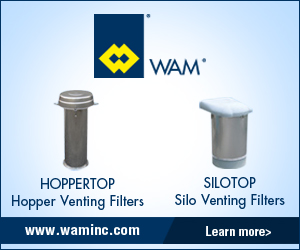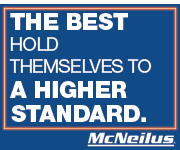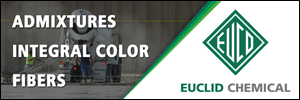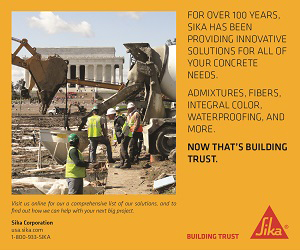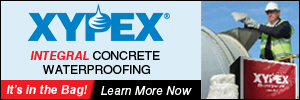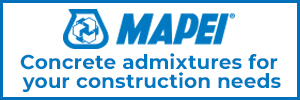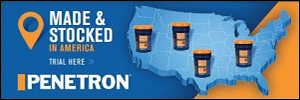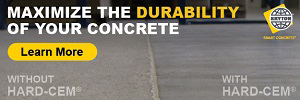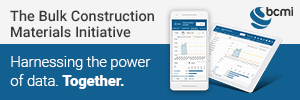 |
||||||||||||
|
||||||||||||
|
Association & Industry News
NRMCA E-NEWS will not be published the week of December 27; the next edition will arrive in your inboxes on January 5, 2022. NRMCA President Michael Philipps, Chief Operating Office Nicole Maher and the staff wish you and your families a happy and healthy holiday season and New Year. NRMCA is still accepting entries for its 2022 Kids Art Contest, sponsored by the Truck Mixer Manufacturers Bureau. The theme for the contest is My Kind of Concrete! The contest is open to children up to grade 12 who have a relationship to an NRMCA Member.
Entries will be divided among the following grade categories: pre-K – K; 1-3, 4-6; 7-12. First, second and third place winners will be selected from each grade category. Prizes will be awarded in each grade category ($100 first; $50 second and $25 third place). Entries will be judged only against others in their grade category on originality, effort, creativity, composition and interpretation of the theme My Kind of Concrete! Winners in each category will be announced at NRMCA’s 2022 Annual Convention, March 15 - 18 in San Antonio, TX. Images of the winning entries will be used later in the year to create a 2023 NRMCA calendar; winners and the sponsoring members will receive a free copy of the calendar. Selected entries will be displayed at NRMCA’s Annual Convention. NRMCA reserves the right to copy and modify any entry for reproduction. Entries will not be returned and may be used for future promotional opportunities. Entries must be postmarked or submitted electronically no later than December 31 and should be mailed or delivered to: Taylor Drzewicki, NRMCA - 66 Canal Center Plaza, Suite 250 - Alexandria, VA 22314. If you have any questions, contact Taylor Drzewicki at tdrzewicki@nrmca.org.
Engineering
NRMCA Engineering Staff has summarized key activity of a virtual ASTM meeting held earlier this month of Committees C09 on Concrete and C01 on Cement. C09.23 Chemical Admixtures - ASTM C1017 A Specification for Flowing Admixtures has been withdrawn as products are not sold under this. The subcommittee discussed developing a method to measure chlorides in admixtures that can be referenced in the specifications. A specification for shrinkage reducing admixtures is in a draft form. Discussed if specifications were needed for hydration control admixtures (currently qualified as Type B or D in ASTM C494), slump retaining admixtures and admixtures to mitigate alkali silica reactions. The subcommittee discussed permitting the use of Type IL (portland limestone cement) for qualifying admixtures as there could be a lack of availability of ASTM C150 Type I cement in the future. C09.24 Supplementary Cementitious Materials - A task group on pozzolanic activity determination discussed a variety of new methods and modification of existing methods to characterize the reactivity of supplementary cementitious materials (SCM) and their impact on strength and durability when used in concrete. The subcommittee has ongoing efforts to develop specifications for colloidal silica and performance-based one for SCMs. There is a proposal to remove limits for loss on ignition (LOI) for fly ash but to require that it be measured and reported. A draft specification for natural pozzolans is being developed to possibly address these products separately from ASTM C618. The subcommittee is working on the inclusion of harvested fly ash in ASTM C618 with minor changes to the requirements. C09.40 Ready Mixed Concrete - A steering committee of the task group chairs met to discuss revisions. Some recent revisions were approved in the current version of the specification for ready mixed concrete, ASTM C94-21b: removal of a numerical limit for time to discharge, an indication that the purchaser should indicate if there is a max temperature for concrete with a note indicating that 95F was specified in ACI standards; revision to measurement accuracy of batch water and a reference to ASTM C1876 that permits the use of ground glass pozzolans. Revisions proposed to ASTM C94 include revise reporting requirements for limits to discharge on the ticket (revs and time); include a requirement to report permitted jobsite water on the delivery ticket; revision to Note 22 regarding max temperature in hot weather; address retesting if slump and air fail specified requirements; include references to C1697 for blended SCM and C1798 for mineral filler as well as the accuracy for batching; revising the appendix table on strength overdesign, and consistent use of the words purchaser and manufacturer. There are several other minor revisions progressing for ASTM C94 and the standards for mixing water ASTM C1602 and C1603. C09.50 Risk Management for Alkali Aggregate Reactions (AAR) - The subcommittee has some revisions in progress to ASTM C1778 to include a reference to the use of ground glass pozzolan with an indication that types with high alkali (Type GS) should be evaluated by ASTM C1293 for a 2-year period; revisions to incorporate guidance on interpretation of results C1778 while deleting the appendix of ASTM C1567. Several possible new business items were discussed. C09.61 Strength - The subcommittee is resolving negatives on a revision to clarify loading rate on beams and a tolerance on the specified test age in ASTM C78. A proposal to require measuring density of fresh concrete when casting cylinders received several negatives that are being addressed. Several other revisions to ASTM C31 are being addressed through balloting. Revisions to ASTM C469 (modulus of elasticity) will include precision statement and revisions will be proposed to update the method for measuring creep, ASTM C512. A precision statement for 4 x 8 in cylinders made in the field has been developed from about 10,000 tests from various sources and will be proposed as a revision to ASTM C39. The subcommittee discussed other items of new business. C09.66 Fluid Penetration - An attempt to withdraw ASTM C642 met some resistance and some minor revisions will be proposed to retain it as an active standard. The subcommittee resolved negatives related to revisions to ASTM C1202 (rapid chloride permeability) relative to specimen thickness used in the calculations for the result. A proposed revision to ASTM C1556 whereby the cast surface should be discarded before conditioning the specimen received negatives that need to be resolved in a re-ballot. Standards ASTM C1757 and ASTM C1792 have been withdrawn. Preliminary results from the ASTM round robin program on surface resistivity, bulk resistivity, ASTM C1202 and ASTM C1556 were presented and discussed. NRMCA participated in the RR program. NRMCA presented results developed at the NRMCA laboratory relative to conditioning of test specimens for the resistivity test. C01.10 Hydraulic Cement - The subcommittee addressed one negative on a revision to remove the autoclave expansion test that measures soundness of cement in ASTM C150. The subcommittee received updates on developments in the Canadian standards for cement, the AASHTO-ASTM harmonization group, and the AASHTO NTPEP program established to test cement sources that could be required by some state DOTs. The subcommittee discussed a need to accommodate cementitious materials that were not hydraulic such as alkali activated material in current or new specifications. For more information, contact Colin Lobo at clobo@nrmca.org or Karthik Obla at kobla@nrmca.org. The National Concrete Pavement Technology Center (CP Tech Center) has released Quality Control for Concrete Paving: A Tool for Agency and Industry, authored by Tara Cavalline (UNC Charlotte), Gary Fick (Transtec) and Al Innis (Holcim). The guide serves as a resource for concrete paving contractors and agency personnel for best quality practices at the batch plant, behind the paver and at other locations on the job. The guide can be used by contractors to improve or enhance their existing QC programs and plans by incorporating into their current operations appropriate tools, processes and procedures likely to meet agency requirements. The guide is also useful for agency personnel as a reference for the components of a comprehensive QC plan for concrete paving projects and includes recommendations for incorporating QC requirements into specifications. Good quality control is an investment that enables increased efficiency and productivity for contractors and can result in safe and long-lasting roads for the traveling public. Resources from the CP Tech Center are available here.
Buildings
NRMCA Launches New Online Course on Advantages of Concrete in Low- to Mid-rise Multifamily Buildings
NRMCA has launched a course titled Advantages of Concrete in Low- to Mid-rise Multifamily for Hanley Wood University. Look around and you’ll see many 5- to 7-story residential projects being built today with one or two floors of concrete, supporting up to 5 floors of steel or wood frame. These “pedestal” projects are assumed to be the cheapest way to build while longer term ownership implications of these designs are not well understood. This 1-hour presentation dispels the myths that are driving the popularity of pedestal construction and demonstrates the ownership value concrete provides, including lower operating costs, less maintenance and improved tenant retention. View the course here. For more information, contact Lionel Lemay at llemay@nrmca.org or 847-922-7995. SEO
Late last Friday a three-judge panel of the 6th Circuit Court of Appeals voted 2-1 in favor of lifting the stay that the 5th Circuit Court of Appeals had imposed in early November on the Occupational Safety and Health Administration’s (OSHA) Emergency Temporary Standard (ETS). The ETS mandates employers with 100 or more employees to require their employees to either get vaccinated against COVID-19 or be subject to weekly testing. The court stated that due to the nature of COVID-19 OSHA “must be able to respond to dangers as they evolve.” Following the court’s ruling, various groups immediately filed appeals with the Supreme Court to halt the 6th Circuit’s ruling. The petitioner’s filings will be fielded by Justice Kavanaugh who has the ability to rule on the appeal by himself or include the full court for a decision. The timing of the Supreme Court’s action is pending, that will also be decided by Justice Kavanaugh. The court’s ruling now allows OSHA to implement and enforce the various ETS provisions for covered employers, but with new compliance dates. Following the court’s ruling OSHA stated that, “To account for any uncertainty created by the stay, OSHA is exercising enforcement discretion with respect to the compliance dates of the ETS. To provide employers with sufficient time to come into compliance, OSHA will not issue citations for noncompliance with any requirements of the ETS before January 10 and will not issue citations for noncompliance with the standard’s testing requirements before February 9, so long as an employer is exercising reasonable, good faith efforts to come into compliance with the standard. OSHA will work closely with the regulated community to provide compliance assistance.” In light of this latest development on OSHA’s ETS, absent an intervention from the Supreme Court to stay or vacate the rule the focus now likely moves to achieving compliance with the various ETS provisions. To this end, NRMCA has created an industry-specific written policy template as is required by the ETS for covered employers. Below are the specific deadlines and pertinent website links for review. Below is a broad synopsis of the ETS as it relates to the ready mixed concrete industry, including the updated compliance deadlines. While not exhaustive, the summary touches on what NRMCA believes to be the larger points of the ETS for general compliance and how it impacts mixer drivers. Does the ETS Apply to the Ready Mixed Concrete Industry? If a ready mixed concrete industry employer has 100 or more employees company-wide, then the employer is covered by the rule. Unfortunately, the threshold of 100 or more employees applies to the employer/company as a whole, NOT per individual location. If an employer has 99 or fewer employees company-wide, then it is not covered by the ETS. What Does the ETS Require? Covered employers must establish a written policy to implement the ETS within the company. The written plan should include items such as:
To assist employers with this lengthy and detailed requirement, OSHA has created a template vaccination/testing policy document. You can also access NRMCA’s written policy template here. Are There Any Exceptions to the ETS? Exceptions to the ETS are few. The ETS specifically does NOT cover employers that are covered by either OSHA’s Healthcare ETS from earlier this year and employers covered by the Federal Contractor Vaccination Mandate since both sets of employers fall under different COVID-19 requirements. As well, when determining the number of employees an employer has, the ETS does NOT require an employer to count independent contractors and leased employees, only full time, part time and temporary workers. The ETS also does NOT apply to “employees who do not report to a workplace where other individuals such as coworkers or customers are present, employees while they are working from home, or employees who work exclusively outdoors.” Essentially, this means the ETS does NOT apply to remote employees or those who work outdoors. Upon further examination of the phrase “employees who work exclusively outdoors,” the text of the ETS states: “An employee will only be covered by the exemption in paragraph (b)(3)(iii) if the employee works exclusively outdoors. Thus, an employee who works indoors on some days and outdoors on other days would not be exempt from the requirements of this ETS. Likewise, if an employee works primarily outdoors but routinely occupies vehicles with other employees as part of work duties, that employee is not covered by the exemption in paragraph (b)(3)(iii). However, if an employee works outdoors for the duration of every workday except for de minimis use of indoor spaces where other individuals may be present – such as a multi-stall bathroom or an administrative office – that employee would be considered to work exclusively outdoors and covered by the exemption under paragraph (b)(3)(iii) as long as time spent indoors is brief, or occurs exclusively in the employee’s home (e.g., a lunch break at home). Extremely brief periods of indoor work would not normally expose employees to a high risk of contracting COVID-19; however, OSHA will look at cumulative time spent indoors to determine whether that time is de minimis. Thus, if there are several brief periods in a day when an employee goes inside, OSHA will total those periods of time when determining whether the exception for exclusively outdoors work applies. Finally, to qualify for this exception, the employee’s work must truly occur “outdoors,” which would not include buildings under construction where substantial portions of the structure are in place, such as walls and ceiling elements that would impede the natural flow of fresh air at the worksite. Workplaces that are truly outdoors typically do not include any of the characteristics that normally enable transmission of SARS-CoV-2 to occur, such as poor ventilation, enclosed spaces, and crowding.” This language could apply to mixer drivers and thus exempt them from vaccination/testing/masking requirements under the ETS if their time spent indoors was brief and infrequent (too small to be considered) and if they remain alone when inside the cab of their truck. *This specific language matches the discussions NRMCA has had with DOL, OSHA and White House OMB about the unique nature of when, where and how mixer drivers conduct their work. It’s important to understand that while the employees outlined above do NOT have to comply with the requirements of the ETS, they are required to be counted in the total number of employees. For example, an employer would still be covered under the ETS if it had 150 employees, but 100 of them were 100% remote. There would still need to be a written plan created and followed for the other 50 employees for vaccinations and/or testing. Compliance Dates The ETS has two different compliance dates associated with specific items. January 10, 2022 (originally December 6, 2021):
February 9, 2022 (originally January 4, 2022):
What Else? While the ETS preempts state and local requirements for COVID-19 procedures, those state and local requirements may still be required in addition to the ETS. An employer’s written plan does NOT have to be submitted to OSHA. However, if requested, the employer is required to provide its written plan to OSHA within 4 business hours of the request. As well, an employer’s written plan should be “readily accessible to all employees.” If an employer already has a vaccination and/or testing requirement in place, that plan will need to be updated or changed to comply with the requirements of the ETS written plan requirements. Workplace-related COVID-19 deaths must be reported to OSHA within 8 hours and in-patient hospitalizations shall be reported to OSHA within 24 hours of learning of the instances. Resources The ETS language, materials, FAQs, fact sheets and written policy templates can be found here. Despite the continued uncertainty of the ETS litigation, NRMCA continues to advocate on and monitor the ETS while updating the membership on its changing status. For more information, contact Kevin Walgenbach at kwalgenbach@nrmca.org. Calendar
Please note that e-mail and direct links to each event listed below can be accessed from NRMCA's Web site. January 11 - 14, Smyrna, TN January 31 - February 2, San Antonio, TX *Sold Out January 31 - February 4, Linthicum Heights, MD February 8 - 11, Phoenix February 14 - 18, Online Course February 15 - 17, Online Course March 22 - 24, Smyrna, TN March 22 - 25, Boston April 4 - 8, Online Course April 19 - 21, Smyrna, TN September 29 - October 3, Aurora, CO |
||||||||||||
